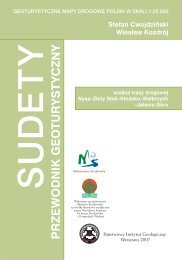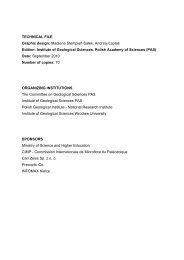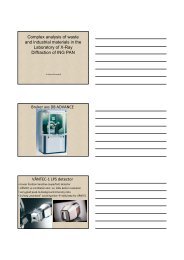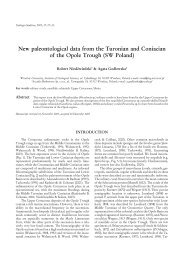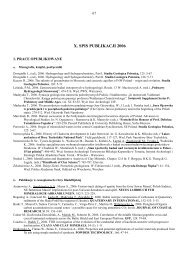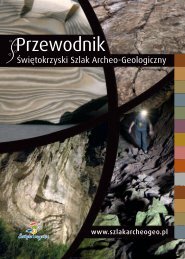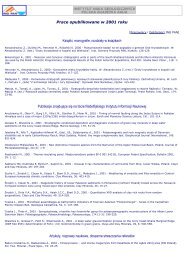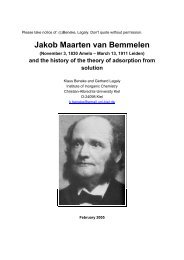Heavy mineral suites in OligoceneâMiocene sediments - Geologia ...
Heavy mineral suites in OligoceneâMiocene sediments - Geologia ...
Heavy mineral suites in OligoceneâMiocene sediments - Geologia ...
You also want an ePaper? Increase the reach of your titles
YUMPU automatically turns print PDFs into web optimized ePapers that Google loves.
2 J. BIERNACKA<strong>m<strong>in</strong>eral</strong> <strong>suites</strong> from the Tertiary North Sea Bas<strong>in</strong> <strong>sediments</strong>was reported e.g. by Morton (1984) and Friis (1974,1978). This study is also aimed to determ<strong>in</strong>e weather<strong>in</strong>gimpact on <strong>m<strong>in</strong>eral</strong> diversity <strong>in</strong> the Oligocene–MioceneSude- tic <strong>sediments</strong> and to assess how much this factorcauses mis<strong>in</strong>terpretation <strong>in</strong> palaeogeographical reconstructions.MATERIALS AND METHODSFig. 1. Location of the B, S and L boreholes <strong>in</strong> the Fore-SudeticMonocl<strong>in</strong>e. OFZ – Odra Fault Zone; SMF – Sudetic Marg<strong>in</strong>alFault.as the effects of denudation of the Fore-Sudetic Block sedimentarycover and the unroof<strong>in</strong>g of crystall<strong>in</strong>e rocks, andthus validated the usability of heavy <strong>m<strong>in</strong>eral</strong> analysis <strong>in</strong>provenance studies <strong>in</strong> this area.<strong>Heavy</strong> <strong>m<strong>in</strong>eral</strong>s, more diverse than the typical assemblageof a sandy light fraction, can provide significantprovenance <strong>in</strong>formation and have been effectively used <strong>in</strong>palaeogeographical reconstructions for many years (e.g.Turnau-Morawska, 1955; Morton, 1985). However, thedistribution of heavy <strong>m<strong>in</strong>eral</strong>s <strong>in</strong> <strong>sediments</strong> is controllednot only by temporal changes <strong>in</strong> the detritus shed from thesource area but also by weather<strong>in</strong>g <strong>in</strong> that area, <strong>in</strong> transitand at the site of deposition, and by hydrodynamic sort<strong>in</strong>gand post-depositional alterations (Morton & Hallsworth,1999). The very strong <strong>in</strong>fluence of these factors on heavyThirty-one samples were taken from the sandy/siltyparts of three cores drilled by the HYDROCONSULTBureau, Poznañ, <strong>in</strong> the Fore-Sudetic Monocl<strong>in</strong>e <strong>in</strong> the vic<strong>in</strong>ityof G³ogów, Zielona Góra and Leszno (the Serby, Bojad³aand Leszno-Zaborowo boreholes, further describedas the S, B and L sections respectively – Fig. 1). The thicknessof the Tertiary <strong>sediments</strong> varied from 150 m (B) to 220m (S), but the bottom of the Tertiary was not pierced. Thecore output <strong>in</strong> each borehole was high enough (ca.70–80%) to conduct sedimentological observations.In order to evaluate the general gra<strong>in</strong>-size distributionof the studied <strong>sediments</strong>, sands were sieved at ca. 0.5 phi <strong>in</strong>tervalsfrom 4 to –2 phi (0.063 to 4 mm). When the <strong>sediments</strong>conta<strong>in</strong>ed significant amounts of f<strong>in</strong>es, the < 0.1mm fraction was analysed us<strong>in</strong>g the pipette method.<strong>Heavy</strong> <strong>m<strong>in</strong>eral</strong>s were separated from the 4 to 3 phi (0.063–0.125 mm) fraction us<strong>in</strong>g an aqua solution of sodiumpolytungstate (specific gravity 2.83). Restrict<strong>in</strong>g the analysisto a s<strong>in</strong>gle, small size fraction reduces effects of hydrodynamicsort<strong>in</strong>g by size, which can bias heavy <strong>m<strong>in</strong>eral</strong>populations and make provenance study difficult (Carver,1971). Moreover, the 4 to 3 phi fraction was found to conta<strong>in</strong>the majority of heavy <strong>m<strong>in</strong>eral</strong>s <strong>in</strong> the Sudetic(Grodzicki, 1972) and North Sea sands (Morton, 1985).M<strong>in</strong>eral gra<strong>in</strong>s were mounted onto a glass slide <strong>in</strong> Canadabalsam and identified us<strong>in</strong>g a petrographic microscope.Approximately 300 translucent heavy <strong>m<strong>in</strong>eral</strong> gra<strong>in</strong>s werecounted <strong>in</strong> randomly selected traverses for each sample.Biotite, chlorite and opaque heavy <strong>m<strong>in</strong>eral</strong>s were alsocounted but omitted <strong>in</strong> the f<strong>in</strong>al specifications for two rea-Lithostratigraphic units* dist<strong>in</strong>guished <strong>in</strong> the S, B and L sectionsTable 1Lithostratigraphic units** Lithostratigraphic units*** Age**** Thickness (meters)Poznañ formationPoznañ fm.Middle to Late Miocene/Early Pliocene 0–55Henryk seam 1I group of seamsMu¿aków formationLusatian seam 2Silesian-Lusatian fm.Œc<strong>in</strong>awa seam 3¯ary formationG³ogów seam 4Paw³owice fm., Adamów fm.II group of seamsŒc<strong>in</strong>awa fm.III group of seamsRawicz fm, ¯ary memberIV group of seamsMiddle Miocene 20–60Early to Early/Middle Miocene 20–35Early Miocene 10–55Lubuska formation Leszno fm. Oligocene 2–90, not pierced*The lithostratigraphic units are diachroneous and their age assignments are approximate.**Lithostratigraphic units after Dyjor (1970, 1986).***Lithostratigraphic units proposed by Piwocki (<strong>in</strong>: Piwocki & Ziêbiñska-Tworzyd³o, 1995) for the Polish Lowland.
HEAVY MINERAL COMPOSITION 3Fig. 2. Measured vertical sections of the Oligocene–Miocene sedimentary rocks from the Fore-Sudetic Monocl<strong>in</strong>e (accord<strong>in</strong>g to Biernacka & Duczmal-Czernikiewicz,unpublished data). Lithostratigraphic units after Dyjor (1970, 1986).
4 J. BIERNACKASummary of the lithological features of the studied sedimentary rocksTable 2cl<strong>in</strong>e (Matl & Œmigielska, 1977; Mart<strong>in</strong>i, 1981). They conta<strong>in</strong>mar<strong>in</strong>e calcareous micro- and macrofossils as well asnannoplankton; accord<strong>in</strong>gly, their correlation with the an-LithostratigraphicunitPoznañformationTextureDescriptionStructurelight green clays, silts; horizons enriched<strong>in</strong> concretions (calcite, siderite, detectable (tectonically disturbed),clays: <strong>in</strong> majority structures non-some septarian)horizontal lam<strong>in</strong>ation, locally numerousleaf impr<strong>in</strong>ts; silts: horizontallam<strong>in</strong>ation, ripple lam<strong>in</strong>ation, smallscale through cross stratificationupper part: light grey, very f<strong>in</strong>e sandsand silts, numerous mica flakes & sideritemicroconcretionshorizontal & ripple lam<strong>in</strong>ation, lowangle cross stratification, locallystrongly bioturbated; L section: 2 mof disturbed <strong>sediments</strong> with convolutebedd<strong>in</strong>g;Interpretation<strong>sediments</strong> deposited from suspensionand from currents; locally subaerialenvironmentshallow mar<strong>in</strong>e (brackish) <strong>sediments</strong>,L section: probable record of anearthquakeMu¿akówformationmiddle part: black muds and clays,lenses of sands, S section - 1-m thicklignite layermiddle part: horizontal lam<strong>in</strong>ation, Ssection - alternately lam<strong>in</strong>ated andbioturbatedlower part: light grey, very f<strong>in</strong>e sandsand silts, numerous mica flakeshorizontal & ripple lam<strong>in</strong>ation, locallybioturbated, muddy <strong>in</strong>traclasts(S section)Silesian-Lusatianformation¯aryformationLubuskaformationma<strong>in</strong>ly black, <strong>in</strong> the upper part greyand beige, muds, clays & very f<strong>in</strong>esands; numerous plant fragments; Ssection: 15 cm <strong>in</strong>terlayer of quartzgravelswhite & grey kaol<strong>in</strong>ite-rich diamictons,clays (kaol<strong>in</strong>s) & gravels, poorlysorted; pebble composition: angularquartz, K-feldspar and lithic gra<strong>in</strong>s(ryolites, mica schists) up to 4 mm(rarely 1 cm);lower part of the S section: black ordark brown clays, muds and sandswith lignite fragmentshorizontal lam<strong>in</strong>ation, flaser, lenticular& wavy bedd<strong>in</strong>g, cross stratification;locally: massive, rootlet tracesmassive (chaotic), locally normallygraded beds, several centimeter clay<strong>in</strong>traclasts <strong>in</strong> clay matrixlower part: horizontal bedd<strong>in</strong>g andripple markslight grey, very f<strong>in</strong>e to f<strong>in</strong>e sands, low angle cross stratification, horizontallam<strong>in</strong>ation, rarely ripple lami-very well sorted, numerous micaflakes, locally enriched <strong>in</strong> small pyrite nation; locally bioturbated (Ophiomorpha,Teichichnus)nodules; lower part: s<strong>in</strong>gle glauconitegra<strong>in</strong>s & foram<strong>in</strong>ifersalluvial - ma<strong>in</strong>ly flood pla<strong>in</strong> with subord<strong>in</strong>atechannel and bar <strong>sediments</strong>, Land B sections: palaeosoil horizonsdebris flow <strong>sediments</strong> on the distalpart of an alluvial fan, the S sectionlocated nearby (< 15 km) fault scarpof uplifted block covered by thickkaol<strong>in</strong>ite-rich weather<strong>in</strong>g residua;lower part: fluvial (flood pla<strong>in</strong>) <strong>sediments</strong>nearshore <strong>sediments</strong> deposited underwell or poorly oxygenated conditions,with diverse sal<strong>in</strong>ity (Gedl,1998)sons. Because of their shape, micas have different hydraulicbehaviour than the rest of the non-opaque <strong>m<strong>in</strong>eral</strong> suite,and are thus particularly sensitive to selective sort<strong>in</strong>g. Furthermore,quantification of micas is difficult because theirdensities straddle that of the heavy liquid. For that reason,the ubiquitous and predom<strong>in</strong>ant muscovite flakes werenot counted at all, and the biotite flakes were not <strong>in</strong>cluded<strong>in</strong> the f<strong>in</strong>al analysis. Opaque <strong>m<strong>in</strong>eral</strong>s were not identifiedaccord<strong>in</strong>g to <strong>m<strong>in</strong>eral</strong> species; as a result, dist<strong>in</strong>guish<strong>in</strong>g diageneticpyrite from detrital opaque heavy <strong>m<strong>in</strong>eral</strong>s wassometimes difficult. Nevertheless, the percentage contentsfor six groups – opaque and translucent heavy <strong>m<strong>in</strong>eral</strong>s,biotite, chlorite, carbonate gra<strong>in</strong>s, and glauconite – werecalculated on the basis of 300 gra<strong>in</strong>s, and are presented <strong>in</strong>Tab. 4.LITHOSTRATIGRAPHY AND DEPOSITIONAL ENVIRONMENTThe Late Eocene glauconitic calcareous sands pass<strong>in</strong>g<strong>in</strong>to the Early Oligocene quartzeous sands are the oldestTertiary <strong>sediments</strong> known from the Fore-Sudetic Mono-
HEAVY MINERAL COMPOSITION 5Gra<strong>in</strong>-size parameters for the studied <strong>sediments</strong> calculated by the graphic methodTable 3SamplesMean,Mz [phi]Sort<strong>in</strong>g,1Skewness,SK1SedimenttypeMu¿aków formation Sil.-Lus. fm. ¯ary formation L. fm.S89 S92 S95 S122.5 S135 S137 S162 S179.5 S202 S212.5 S249 S2643.6 3.9 4.3 4.0 4.0 4.6 3.6 3.4 10.5 6.1 3.2 2.91.1 0.9 1.2 0.7 0.6 0.7 0.7 1.0 8.2 5.3 1.6 1.20.6 0.4 0.5 0.1 0.1 0.6 0.6 0.4 0.5 0.4 0.3 0.6f<strong>in</strong>e sandv. f<strong>in</strong>esandv. f<strong>in</strong>esandv. f<strong>in</strong>esandv. f<strong>in</strong>esandsiltv. f<strong>in</strong>esandv. f<strong>in</strong>esandsandyclaysandyclayv. f<strong>in</strong>esandf<strong>in</strong>e sandSamplesS.-L. fm. ¯ary formation Lubuska FormationB157 B161.7 B177 B124 B220 B229 B234 B244 B258Mean,Mz [phi]3.6 3.2 3.3 2.9 3.0 3.3 3.3 3.3 3.5Sort<strong>in</strong>g, 1 1.4 0.7 2.5 0.5 0.3 0.4 0.4 0.3 1.1Skewness,SK10.5 0.6 0.8 0.2 0.4 0.3 0.2 0.1 0.1Sedimenttypev. f<strong>in</strong>e sand v. f<strong>in</strong>e sand f<strong>in</strong>e sand f<strong>in</strong>e sand f<strong>in</strong>e sand v. f<strong>in</strong>e sand v. f<strong>in</strong>e sand v. f<strong>in</strong>e sand v. f<strong>in</strong>e sandSamplesPoznañ formation Mu¿aków formation Sil.-Lus. fm.. ¯ary fm. L. fm.L65.5 L71 L123 L128.5 L151 L154.5 L168.5 L182 L206 L218.7Mean,Mz [phi]5.1 5.7 5.1 5.0 4.7 4.5 7.7 4.2 4.2 4.9Sort<strong>in</strong>g, 1 3.5 =1.3 1.9 1.7 1.8 5.0 0.7 1.1 0.3Skewness,SK10.8 0.9 0.8 0.7 0.6 0.7 0.4 0.3 0.3Sedimenttypesilt silt silt silt silt sandy silt silt sandy silt sandy silt siltcient North Sea and Paratethys Bas<strong>in</strong> <strong>sediments</strong> was possible(op. cit.). The overly<strong>in</strong>g deposits lack calcareous fauna,so parastratigraphic palaeobotanical zones were dist<strong>in</strong>guished<strong>in</strong> the Upper Oligocene and Neogene sections,based on a model of cyclic climatic changes. It was neverpossible to create a precise geochronological scale or makeexact correlations with the North Sea and Paratethys subdivisions,although the close proximity of the Silesian partof the Paratethys permitted comparative palynologicalstudies to be carried out, giv<strong>in</strong>g some def<strong>in</strong>ition to thechronology (e.g. Dyjor & Sadowska, 1986).In none of the exam<strong>in</strong>ed cores was a Tertiary basementobserved, and all of the cores lack the glauconite-rich sandsof the Upper Eocene. The studied <strong>sediments</strong> were classifiedaccord<strong>in</strong>g to the <strong>in</strong>formal lithostratigraphic subdivisionproposed by Dyjor (1970) for the area of the Fore-SudeticBlock and Monocl<strong>in</strong>e (Tab. 1, Fig. 2). For comparison, thelithostratigraphic scheme after Piwocki (<strong>in</strong>: Piwocki &Ziembiñska-Tworzyd³o, 1995) for the Polish Lowland isalso presented <strong>in</strong> Tab. 1. In the subdivision used here, ligniteseams mark the boundaries of the lithostratigraphicalunits, the age of which was determ<strong>in</strong>ed on the basis of numerouspalynological studies conducted for the area of theFore-Sudetic Block and Monocl<strong>in</strong>e, and neighbour<strong>in</strong>g areas(e.g. Sadowska, 1995). However, because of the diachronityof the lithostratigraphic units, the age designationsused <strong>in</strong> this paper are approximate.In order to check the age and depositional environmentof the exam<strong>in</strong>ed <strong>sediments</strong>, thirty-three samplesfrom three sections were chosen for d<strong>in</strong>oflagellate analysis.Only the <strong>sediments</strong> of the Lubuska formation from the Bsection conta<strong>in</strong>ed well-preserved and diverse assemblagesof d<strong>in</strong>oflagellate cysts, which were <strong>in</strong>terpreted as Oligocene<strong>in</strong> age, deposited <strong>in</strong> a mar<strong>in</strong>e/brackish environmentof variable sal<strong>in</strong>ity (Gedl, 1998). The <strong>sediments</strong> were classifiedas belong<strong>in</strong>g to the Lower and Upper Oligocene, althoughthe boundary between them was not precisely determ<strong>in</strong>ed(op. cit.). Except for the clayey lowest part, no significantlithological changes were observed. Thus, the conductedstudies confirmed the Oligocene age of the Lubuskaformation, assumed <strong>in</strong> exist<strong>in</strong>g lithostratigraphic schemes.A short description of lithology is <strong>in</strong>cluded <strong>in</strong> Tab. 2,and the gra<strong>in</strong>-size parameters calculated for the studied<strong>sediments</strong> are listed <strong>in</strong> Tab. 3. The depositional environmentswere <strong>in</strong>terpreted on the basis of sediment texturesand structures, <strong>in</strong>clud<strong>in</strong>g <strong>m<strong>in</strong>eral</strong> composition. Several
6 J. BIERNACKAQuantitative composition of the heavy components <strong>in</strong> the 3–4 phi fraction (<strong>in</strong> gra<strong>in</strong> %)Table 4Sample<strong>Heavy</strong> fractioncontent[weight %]Opaque <strong>m<strong>in</strong>eral</strong>sTranslucent<strong>m<strong>in</strong>eral</strong>s*Biotite Chlorite Carbonate gra<strong>in</strong>s GlauconiteS89 1.1** 32 66 0 2 0 0S92 0.3 21.5 34 1 0.5 41.5 1.5S95 0.1 17 15 4 0.5 63 0.5S122.5 0.5 56 35 5 3.5 0.5 0S135 0.4 59 38 1 2 0 0S137 0.4 67 17 13 3 0 0S162 0.3 71 29 0 0 0 0S179.5 0.2 70 29 0 0 1 0S202 0.3 53.5 46.5 0 0 0 0S212.5 0.5 74 26 0 0 0 0S249 0.8 35 65 0 0 0 0S264 0.2 57 42 0 0 1 0B157 0.2 62 38 0 0 0 0B161.7 0.6 46 54 0 0 0 0B177 0.7*** 54 46 0 0 0 0B214 0.5 58 42 0 0 0 0B220 0.5 60 40 0 0 0 0B229 0.3 70 24.5 0.5 5 0 0B234 0.2 55 30 1 14 0 0B244 0.2 53 33 1 13 0 0B258 1.0*** 83.5 14 0.5 2 0 0L65.5 0.1 55 38 0 0 7 0L71 0.2 47 48 0 4 0 0L123 0.7** 8 3 7 0 75.5 1.5L128.5 0.6** 35.5 20 0.5 0 41.5 1.5L151 1.6** 57.5 36 0 0 1.5 0L154.5 0.3 59 20 6 0 0 0L168.5 0.1 75.5 24.5 0 0 0 0L182 0.2*** 91.5 8 0 0 0 0L206 0.9*** 85 15 0 0 0 0L218.7 0.1 64 35 1 0 0 0* Translucent heavy <strong>m<strong>in</strong>eral</strong>s without biotite and chlorite** Muscovite-rich samples*** Pyrite-rich samplesl<strong>in</strong>es of evidence suggest that the sands and silts of theLubuska and Mu¿aków formations were deposited <strong>in</strong> ashallow mar<strong>in</strong>e environment (see Tab. 2). The rema<strong>in</strong><strong>in</strong>g<strong>sediments</strong> were deposited <strong>in</strong> alluvial sett<strong>in</strong>gs. The clays andsilts of the Poznañ formation, present only <strong>in</strong> the L section,are for the most part tectonically disturbed; therefore,they are not <strong>in</strong>terpreted <strong>in</strong> terms of their depositionalenvironment.RESULTSThe quantitative composition of the heavy fraction <strong>in</strong>the Oligocene–Miocene sands and silts is presented <strong>in</strong> Tab.4, and the composition of the non-micaceous translucentheavy <strong>m<strong>in</strong>eral</strong>s is given <strong>in</strong> Tab. 5. A comparison of the contentof key heavy <strong>m<strong>in</strong>eral</strong>s <strong>in</strong> five subsequent formations ispresented <strong>in</strong> Fig. 3. In the case of a strong <strong>m<strong>in</strong>eral</strong> diversity
HEAVY MINERAL COMPOSITION 7Composition of the translucent heavy <strong>m<strong>in</strong>eral</strong>s (<strong>in</strong> gra<strong>in</strong> %, <strong>in</strong> the 3–4 phi fraction)from the Oligocene and Miocene <strong>sediments</strong>, Fore-Sudetic Monocl<strong>in</strong>eTable 5S89 S92 S95 S122.5 S135 S137 S162 S179.5 S202 S212.5 S249 S264Zircon 4 3 6 12 7 3 8 28 14.5 24.5 1 2.5Tourmal<strong>in</strong>e 10 13 18 17 23 25 26 24 23 8 8.5 11Rutile 8 8 4 7 12.5 4 23 21 2.5 8.5 2.5 4.5ZTR <strong>in</strong>dex 22 24 28 36 42.5 32 57 73 40 41 12 18Andalusite 2.5 1.5 3.5 14 11 7 3.5 1 34 17.5 21 21.5Syllimanite 0 2 2.5 6 11 12 6 1 0.5 1 3 5Kyanite 0.5 0.5 1.5 3 5 8 5.5 3 1 1 1 9Garnet 55 50.5 40 10.5 5 6 2 1 0 0 2 2Staurolite 3 6 6.5 4 4 6 14.5 10 0 2.5 13 29Epidote group* 4 2 1 11 9 14 0 2 0.5 11 34 9Apatite 5 7 10.5 2 0 0 0 0 0 0 0 0Anatase** 6 4.5 4.5 12 9.5 13 9.5 6.5 23 25.5 2 4Others 2 2 2 1.5 2 2 1 2.5 2 0.5 2 2.5Number ofcounted gra<strong>in</strong>s317 307 238 333 310 142 291 208 318 335 314 302B157 B161.7 B177 B214 B220 B229 B234 B244 B258Zircon 1 5.5 15 7.5 12 1 1.5 2 25Tourmal<strong>in</strong>e 24 17 15 15 15 15 13 10 9Rutile 2 4 11 12 14 4 4 4 5ZTR <strong>in</strong>dex 27 26.5 41 34.5 41 20 18.5 16 39Andalusite 36.5 22 14 9.5 3 6 14 8.5 4Syllimanite 9 3 10 13 14 18 19 13.5 5Kyanite 5 5 9 13 11 26 17 17 7Garnet 2 5.5 1 18 19 20 18 14 15Staurolite 5 5 18 6 6 2 5 3 5Epidote group* 5 20.5 1 1 0 1 0.5 11 20Apatite 1 0 0 0 0 0 0 2 2Anatase** 8 7 5 2 4 5 6 10 1Others 1.5 5.5 1 3 2 2 2 5 2Number ofcounted gra<strong>in</strong>s318 311 300 300 300 300 300 300 300L65.5 L71 L123 L128.5 L151 L154.5 L168.5 L182 L206 L218.7Zircon 17.5 9 2.5 1.5 11 3.5 13 11.5 1 0Tourmal<strong>in</strong>e 22.5 30 29.5 30.5 12 14.5 33 32 28 61Rutile 13.5 12 0 2 3 9 15 15 1.5 0ZTR <strong>in</strong>dex 53.5 51 32 34 26 27 61 58.5 30.5 61Andalusite 0 0.5 0 5 9.5 6 0 3.5 14 14.5Syllimanite 2 1 3.5 2 4 7.5 1.5 5 3 5.5Kyanite 1 0 2 0 3 13 7 4 11 10.5Garnet 16 21.5 27 22.5 5 5 0 2.5 0 0Staurolite 5 6 5 6 8.5 11.5 9.5 14 21 2Epidote group* 5 4 6 6.5 32.5 17 1.5 1 10.5 0Apatite 0 0.5 14 10 0 1.5 0 0 0 0Anatase** 16.5 11.5 9.5 11.5 6 10 18 9.5 6.5 0.5Others 1 3.5 1 2.5 5.5 1.5 0.5 2 3.5 6Number ofcounted gra<strong>in</strong>s305 325 85 336 305 146 256 204 250 270* Epidote group and m<strong>in</strong>or zoisite; ** Anatase and m<strong>in</strong>or titanite; L218.7 – fraction 2–3 phi
8 J. BIERNACKAFig. 3. Content of major heavy <strong>m<strong>in</strong>eral</strong>s <strong>in</strong> the Oligocene–Miocene <strong>sediments</strong>, Fore-Sudetic Monocl<strong>in</strong>e, shown as percentages of thetotal non-opaque heavy <strong>m<strong>in</strong>eral</strong>s. ZTR – zircon, tourmal<strong>in</strong>e and rutile; And – andalusite; S-K – sillimanite and kyanite; St – staurolite;Ep – epidote; Grt – garnet; Ap – apatite; Ana – anatase. ¯ary fm.* – L, B and lower part of S sections.<strong>in</strong> the samples from one formation, the heavy <strong>m<strong>in</strong>eral</strong> contentis shown <strong>in</strong> separate diagrams (Fig. 3A–B).The heavy fraction content is diverse, but, generally, itexceeds 0.5% (by weight) <strong>in</strong> samples rich <strong>in</strong> mica, authigenicpyrite or siderite microconcretions. The latter arepresent <strong>in</strong> significant amounts only <strong>in</strong> the upper part of theMu¿aków formation, where, other than siderite, glauconitegra<strong>in</strong>s have been observed. Biotite is relatively common<strong>in</strong> the Lubuska and Mu¿aków formations, and chlorite<strong>in</strong> the Lubuska, Mu¿aków and Poznañ ones. The opaque<strong>m<strong>in</strong>eral</strong> content (average 56% as a gra<strong>in</strong> percentage ofthe heavy fraction) is also very diverse; opaque <strong>m<strong>in</strong>eral</strong>s aredom<strong>in</strong>ated <strong>in</strong> many samples by authigenic pyrite. Otherthan pyrite, leucoxene occurs <strong>in</strong> considerable amounts.
HEAVY MINERAL COMPOSITION 9Fig. 4. SEM photomicrograph of different morphological typesof tourmal<strong>in</strong>es. Sample S179.5.The content for a given heavy <strong>m<strong>in</strong>eral</strong> is reported hereafteras a percentage of the total translucent non-micaceousheavy <strong>m<strong>in</strong>eral</strong> assemblage content. The ZTR <strong>in</strong>dex (sum ofthe percentage contents of zircon, tourmal<strong>in</strong>e and rutile –Hubert, 1962) varies between 12% and 73%. It reaches itshighest values <strong>in</strong> the Silesian-Lusatian and Poznañ formations(average 50% and 52%, respectively), and its lowest <strong>in</strong>the Mu¿aków and ¯ary formations (average 30% and28%). Of the ultra-stable heavy <strong>m<strong>in</strong>eral</strong>s, tourmal<strong>in</strong>e ismuch more abundant than zircon and rutile. In some samples,its content exceeds several times that of zircon or rutile.Moreover, the average content of tourmal<strong>in</strong>e <strong>in</strong> the Lsamples is almost twice that of the S or B samples (29%,17%, 17% respectively). The tourmal<strong>in</strong>e gra<strong>in</strong>s have dist<strong>in</strong>ctpleochroism (light yellow to dark brown, rarely lightblue to navy blue) and are of two major morphologicaltypes, rounded and euhedral (Fig. 4); both types are present<strong>in</strong> the majority of the studied samples. Sharp-edgedspl<strong>in</strong>ters were also found. Sample L 218.7 is an exception –it has a 61% tourmal<strong>in</strong>e content, and almost all the tourmal<strong>in</strong>egra<strong>in</strong>s are rounded. Significant amounts of zircon occur<strong>in</strong> the Poznañ, ¯ary (alluvial fan) and Silesian-Lusatianformations (average 13%, 19.5% and 11% respectively).Both rounded and euhedral zircon gra<strong>in</strong>s are present <strong>in</strong> the<strong>sediments</strong>.M<strong>in</strong>erals of the Al 2 SiO 5 group, <strong>in</strong>clud<strong>in</strong>g andalusite,sillimanite and kyanite, are found <strong>in</strong> all the studied samples,although <strong>in</strong> the silts of the Poznañ formation theircontent is dramatically lower than elsewhere, and averages2%. These <strong>m<strong>in</strong>eral</strong>s are also uncommon <strong>in</strong> the upper partof the Mu¿aków formation with an average content of 5%.Fig. 5. SEM photomicrographs of partly dissolved heavy <strong>m<strong>in</strong>eral</strong>s. A – garnet, L123; B – sillimanite, B157; C – epidote, S249; D –staurolite, L123.
10 J. BIERNACKAAndalusite, which here rarely displays p<strong>in</strong>k pleochroism,is usually more abundant than sillimanite or kyanite, andreaches peaks of 29% and 26% (average content) <strong>in</strong> theSilesian-Lusatian (B section) and ¯ary (alluvial fan) formations,respectively. The Lubuska formation is characterizedby the highest content of sillimanite and kyanitegra<strong>in</strong>s (average <strong>in</strong> the B section – 29%); the sillimanite contentis comparable with that of kyanite, and, <strong>in</strong> the majorityof the B samples, is even higher than the andalusite content.All the Al 2 SiO 5 <strong>m<strong>in</strong>eral</strong>s <strong>in</strong> the Lubuska formationare fresh, non-altered and non-rounded, with sharp edges.By contrast, these <strong>m<strong>in</strong>eral</strong>s (especially sillimanite) showtraces of corrosion <strong>in</strong> samples from the upper part of thesection (Fig. 5B).The average staurolite content is 5–10%, although <strong>in</strong>the ¯ary formation it is present <strong>in</strong> a wide range of quantities.It is rare <strong>in</strong> the kaol<strong>in</strong>s of the ¯ary formation (alluvialfan facies; av. 1%) but reaches a peak of 24% (av.) <strong>in</strong> the Land lower part of the S and B sections (Fig. 2). The staurolitegra<strong>in</strong>s frequently show traces of dissolution (Fig. 5D),especially <strong>in</strong> the Silesian-Lusatian formation.Epidote group <strong>m<strong>in</strong>eral</strong>s, <strong>in</strong>clud<strong>in</strong>g epidote, cl<strong>in</strong>ozoisiteand zoisite, are present <strong>in</strong> a range of quantities from anaverage of 1% <strong>in</strong> the Silesian-Lusatian formation (the L andS sections) to 18% (av.) <strong>in</strong> the ¯ary formation and 17% (av.)<strong>in</strong> the lower part of the Mu¿aków formation. The contentof these <strong>m<strong>in</strong>eral</strong>s <strong>in</strong> the Lubuska formation also varies between0% and 20%. The epidote gra<strong>in</strong>s are either stronglyaltered, corroded (Fig. 5C) and even partly opaque, orfresh and transparent. Both types are present <strong>in</strong> almost allthe samples; <strong>in</strong> general, the amount of non-altered gra<strong>in</strong>s<strong>in</strong>creases with <strong>in</strong>creas<strong>in</strong>g epidote content.The garnet content displays considerable variation.Garnets are almost absent <strong>in</strong> the ¯ary and Silesian-Lusatianformations (ca. 1%), while they make up 6% and 17% (av.)of the transluscent heavy <strong>m<strong>in</strong>eral</strong> content <strong>in</strong> the lower partof the Mu¿aków and Lubuska formations, respectively,and 39% and 19% (av.) <strong>in</strong> the upper part of the Mu¿akówand Poznañ formations, respectively. In the majority ofthe samples, the garnets are partly dissolved, occurr<strong>in</strong>g <strong>in</strong>the form of so-called facetted gra<strong>in</strong>s (Fig. 5A).Apatite occurs <strong>in</strong> m<strong>in</strong>or amounts only <strong>in</strong> the Lubuskaand Mu¿aków formations, but <strong>in</strong> the latter, it is found <strong>in</strong> arange of quantities The lower part of the Mu¿aków formationconta<strong>in</strong>s an average of 1% apatite, and the upper part9% (av.). The majority of apatite gra<strong>in</strong>s <strong>in</strong> the upper part ofthe Mu¿aków formation occur as colourless, transparent,long-prism crystals of euhedral habit.Anatase makes up from 0% to 14% of the translucentheavy <strong>m<strong>in</strong>eral</strong> content, with the exception of samples fromthe kaol<strong>in</strong>s of the ¯ary formation, where its content averages24%. The anatase occurs <strong>in</strong> the <strong>sediments</strong> <strong>in</strong> the formof small euhedral crystals grouped <strong>in</strong> aggregates.Other <strong>m<strong>in</strong>eral</strong>s, occurr<strong>in</strong>g <strong>in</strong> negligible amounts, <strong>in</strong>cludetitanite, topase, Cr sp<strong>in</strong>el and vesuvian (?). Topaseand sp<strong>in</strong>el occur <strong>in</strong> the Mu¿aków formation; titanite andvesuvian (?) were found <strong>in</strong> sands of the Lubuska formation.INTERPRETATIONThe S, B and L sections are located <strong>in</strong> the foreland ofthe Sudetes Mts. and the Fore-Sudetic Block; therefore, detritalmaterial must have been at least partly delivered fromtheir denudation. However, the Oligocene and Miocenegeographical frame differed from that of the present-day: adist<strong>in</strong>ct morphological partition between the Sudetes Mts.and the Fore-Sudetic Block did not exist. Although the onsetof dislocations along the Sudetic Marg<strong>in</strong>al Fault, whichseparates the two units, is dated for the Late Oligocene(Grocholski, 1977; Birkenmajer et al., 1977), this is still asubject of controversy, and Early Miocene (Dyjor, 1975,1986), Late Miocene (Oberc & Dyjor, 1969; Dyjor &Kuszell, 1977) and even Pliocene ages (Wojewoda et al.,1995) are also considered. The present-day Sudetes Mts. arecomposed of a mosaic of crystall<strong>in</strong>e and sedimentary rocksthat are relatively well exposed. By contrast, the crystall<strong>in</strong>ebasement of the Fore-Sudetic Block is covered by thickCa<strong>in</strong>ozoic <strong>sediments</strong> and available for direct observationsonly <strong>in</strong> crystall<strong>in</strong>e islands. Its lithology is known fromdrill<strong>in</strong>gs and geophysical data, and considered to be a cont<strong>in</strong>uationof the Sudetes Mts. basement and to represent a5-km deeper crustal level (Cwojdziñski & ¯elaŸniewicz,1995).AssumptionsLarge lithological diversity <strong>in</strong> a relatively small areaand complicated relationships between geological unitsmake provenance study difficult, and can lead to ambiguousresults. Therefore, for the purpose of this study, only afew areas that are the sources of characteristic heavy <strong>m<strong>in</strong>eral</strong>assemblages were chosen (see Fig. 7) and assessed.1. The epimetamorphic Kaczawa complex occurs <strong>in</strong>both the Fore-Sudetic Block and the Sudetes Mts., and iscomposed of metamorphosed volcanogenic and sedimentaryrocks. Epidote, chlorite and act<strong>in</strong>olite are typical forthese rocks (e.g. Baranowski et al., 1990).2. The Góry Sowie gneiss-migmatite complex and itseastern surround<strong>in</strong>g are composed of a mesozonal gneissschistassemblage (Niemcza Zone, Kamieniec Z¹bkowickiand Doboszowice Metamorphic Units, Strzel<strong>in</strong> Massif).The characteristic heavy <strong>m<strong>in</strong>eral</strong>s <strong>in</strong>clude sillimanite, kyaniteand garnet; andalusite, staurolite, tourmal<strong>in</strong>e and zirconmay be also present (e.g. Kryza, 1981; Oberc-Dziedzic,1999; Achramowicz et al., 1997).3. The Strzegom-Sobótka granite massif and its metamorphiccover are located <strong>in</strong> the Fore-Sudetic Block, andare the source of zircon, apatite, biotite, hornblende, andalusite,garnet, chlorite, titanite, tourmal<strong>in</strong>e (Majerowicz,1972).
HEAVY MINERAL COMPOSITION 114. The Karkonosze granite and the Izera gneisses areboth <strong>in</strong> the Sudetes Mts. The heavy <strong>m<strong>in</strong>eral</strong>s derived fromthese units are ma<strong>in</strong>ly biotite, zircon, apatite, tourmal<strong>in</strong>e,garnet, andalusite, topase (Borkowska, 1966; Wieser,1958).Although <strong>in</strong>dividual heavy <strong>m<strong>in</strong>eral</strong>s may be deliveredfrom different rocks and areas, heavy <strong>m<strong>in</strong>eral</strong> assemblagesmay, to some extent, be diagnostic for transport directions.Moreover, although only metamorphic/igneous complexesare considered here, sedimentary rocks also provideddetrital material to thie studied area, as is best evidencedby the occurrence of rounded gra<strong>in</strong>s of tourmal<strong>in</strong>e,zircon and rutile. However, such gra<strong>in</strong>s are only dom<strong>in</strong>ant<strong>in</strong> one of the analysed <strong>m<strong>in</strong>eral</strong> <strong>suites</strong>. On the other hand,many Sudetic sedimentary rocks conta<strong>in</strong> non-roundedheavy <strong>m<strong>in</strong>eral</strong>s that were supplied from Sudetic crystall<strong>in</strong>erocks (e.g. Felicka, 2000), and as such are not easy to identify.Oligocene <strong>sediments</strong> cover the northwestern part ofthe Fore-Sudetic Block and Miocene deposits lie even furtherto the east (Oberc & Dyjor, 1969; Dyjor, 1974, 1986).Hence, s<strong>in</strong>ce the Oligocene this territory had not constituteda denudation site but rather a depositional site, and assuch is excluded from the prospective source areas.Weather<strong>in</strong>g impactWeather<strong>in</strong>g and diagenesis create additional complications<strong>in</strong> provenance study. The unquestionable obstacle to<strong>in</strong>terpret<strong>in</strong>g source areas <strong>in</strong> the case studied is the lack ofunstable/semi-stable heavy <strong>m<strong>in</strong>eral</strong>s, such as oliv<strong>in</strong>es,pyroxenes and amphiboles, among the recognized heavy<strong>m<strong>in</strong>eral</strong> <strong>suites</strong>. This means that the latter do not reflect thewhole composition of the heavy fraction <strong>in</strong> the parentrocks and, further, that the proportions between the rema<strong>in</strong><strong>in</strong>gheavy <strong>m<strong>in</strong>eral</strong>s may be strongly biased by weather<strong>in</strong>g/diageneticprocesses.The problem of the relative chemical stability of heavy<strong>m<strong>in</strong>eral</strong>s has a long research history (e.g. Pettijohn, 1941;Hubert, 1962; Morton, 1984; Morton & Hallsworth, 1999and refs. there<strong>in</strong>). Based on the gradual decrease <strong>in</strong> unstableheavy <strong>m<strong>in</strong>eral</strong> contents downwards <strong>in</strong> some stratigraphic<strong>in</strong>tervals and a comparison of the heavy <strong>m<strong>in</strong>eral</strong> <strong>suites</strong> <strong>in</strong>impermeable concretions and surround<strong>in</strong>g porous sands,<strong>m<strong>in</strong>eral</strong>s were divided <strong>in</strong>to several stability groups fromunstable oliv<strong>in</strong>es to ultrastable ZTR (op. cit.). Morton(1984) proposed the follow<strong>in</strong>g order of stability of somecommon heavy <strong>m<strong>in</strong>eral</strong>s <strong>in</strong> the presence of acid solutions:oliv<strong>in</strong>e, pyroxene
12 J. BIERNACKAFig. 6. Diagram show<strong>in</strong>g the variation <strong>in</strong> the content of some heavy <strong>m<strong>in</strong>eral</strong>s with depth <strong>in</strong> the sands of the Lubuska formation (B section).that the upper part of the Lubuska formation is also impoverished<strong>in</strong> some heavy <strong>m<strong>in</strong>eral</strong>s.By marked contrast, the lower part of the Lubuska formationand the Mu¿akow formation conta<strong>in</strong> more diverse<strong>m<strong>in</strong>eral</strong> assemblages, <strong>in</strong>clud<strong>in</strong>g semi-stable apatite, titaniteand biotite. These formations are <strong>in</strong>terpreted as mar<strong>in</strong>e/brackish<strong>in</strong> orig<strong>in</strong>, which confirms the observation ofFriis (1974, 1978) that, as far as heavy <strong>m<strong>in</strong>eral</strong>s are concerned,mar<strong>in</strong>e <strong>sediments</strong> have a higher preservation potentialthat terrestrial ones; the latter undergo more <strong>in</strong>tensiveweather<strong>in</strong>g processes due to their longer exposure toweather<strong>in</strong>g agents. In the studied case, however, the sourcerocks underwent such deep weather<strong>in</strong>g that all the pyroxeneand amphibole gra<strong>in</strong>s were destroyed and are miss<strong>in</strong>geven from the mar<strong>in</strong>e <strong>sediments</strong>. This is the significant difference<strong>in</strong> comparison with the Tertiary <strong>sediments</strong> com<strong>in</strong>gfrom the denudation of the Fennoscandian shield, forwhich amphibole is a typical <strong>m<strong>in</strong>eral</strong> (Morton et al., 1988;Kosmowska-Ceranowicz, 1979). In the Palaeogene, andpossibly even earlier, the Sudetes Mts. must have undergonemuch more <strong>in</strong>tensive weather<strong>in</strong>g than the Fennoscandianarea.Weather<strong>in</strong>g and diagenesis did not exclusively lead to<strong>m<strong>in</strong>eral</strong> dissolution: anatase gra<strong>in</strong>s present <strong>in</strong> the majorityof the studied samples exhibit features that <strong>in</strong>dicate crystallizationfrom pore-fluids <strong>in</strong> the <strong>sediments</strong>; they are composedof small anatase crystals (ca. 10 µm <strong>in</strong> size) of euhedralhabits grouped <strong>in</strong> several <strong>in</strong> separate gra<strong>in</strong>s. The highestamount of anatase (25.5%) was found <strong>in</strong> the kaol<strong>in</strong>iteclays of the ¯ary formation. Such anatase gra<strong>in</strong>s could beboth redeposited from the Tertiary soils and directlyformed <strong>in</strong> the studied <strong>sediments</strong>. Investigations of presentdaysoil profiles show that under strong tropical weather<strong>in</strong>gconditions titanium may be mobile, and when releasedfrom primary <strong>m<strong>in</strong>eral</strong>s (ilmenite, pseudorutile, anatase, rutile),it precipitates as anatase (e.g. Berrow et al., 1978;Cornu et al., 1999). As demonstrated by Weaver (1976), themost common forms of titanium <strong>in</strong> kaol<strong>in</strong>ite clays are residualrutile, <strong>in</strong>herited from weather<strong>in</strong>g of the bedrock,and neoformed anatase. Accord<strong>in</strong>gly, <strong>in</strong> addition to thelack of semi-stable <strong>m<strong>in</strong>eral</strong>s and the high ZTR <strong>in</strong>dex, a highcontent of neoformed anatase may be treated as another <strong>in</strong>dicatorof weather<strong>in</strong>g <strong>in</strong>tensity.Hydrodynamic sort<strong>in</strong>gAlthough heavy <strong>m<strong>in</strong>eral</strong> analysis is restricted <strong>in</strong> thisstudy to a narrow sediment fraction (3–4 phi), the effects ofhydrodynamic sort<strong>in</strong>g of <strong>m<strong>in</strong>eral</strong>s by density may be locallyrecognized. The most conspicuous example is therelatively high concentration of tourmal<strong>in</strong>es, heavy <strong>m<strong>in</strong>eral</strong>sof relatively low density, <strong>in</strong> the <strong>sediments</strong> of the L section,which is located furthermost from the source area.Another example is discussed below.Provenance historyEven tak<strong>in</strong>g all the above limitations and simplifications<strong>in</strong>to account, there are still some provenance <strong>in</strong>dicative<strong>m<strong>in</strong>eral</strong> assemblages, which allow the study of the directionsof detritus transport <strong>in</strong> the Oligocene and Miocene.It is worth not<strong>in</strong>g that the marked dom<strong>in</strong>ance off<strong>in</strong>e-gra<strong>in</strong>ed <strong>sediments</strong> <strong>in</strong> all the studied sections (Tab. 3)suggests relatively low relief and a lack of significant differences<strong>in</strong> altitude <strong>in</strong> the study area dur<strong>in</strong>g that time.The sands and silts of the Oligocene Lubuska formationconta<strong>in</strong> the most characteristic heavy <strong>m<strong>in</strong>eral</strong> assemblage,composed of fresh and non-rounded <strong>m<strong>in</strong>eral</strong>s that
HEAVY MINERAL COMPOSITION 13Fig. 7. Probable source areas (<strong>in</strong> circles) for the Oligocene–Miocene <strong>sediments</strong> of the Fore-Sudetic Monocl<strong>in</strong>e. Sketch geological map(only selected units) of the Sudetes Mts. and the Fore-Sudetic Block after Sawicki (1965), Grocholski (1982), and Cwojdziñski &¯elaŸniewicz (1995). OFZ – Odra Fault Zone; SMF – Sudetic Marg<strong>in</strong>al Fault; KZ – Kamieniec Z¹bkowicki.were delivered from high-grade metamorphic rocks. Notonly sillimanites (up to 19%) and kyanites (up to 26%) butalso garnets, biotites and at least a part of the zircons, tourmal<strong>in</strong>esand rutiles could have derived from the samesource rocks, i.e. granulites, syllimanite gneisses, etc. Thewhole suite strongly po<strong>in</strong>ts to the central part of the Fore-Sudetic Block, i.e. the Góry Sowie Block, Strzel<strong>in</strong> Massifand Niemcza Zone (Fig. 7A). Although the studied sectionsare situated <strong>in</strong> the direct foreland of the Kaczawacomplex, epidote, a typical <strong>m<strong>in</strong>eral</strong>, is not predom<strong>in</strong>ant.This suggests that this area did not supply the majority ofthe detrital material. Moreover, the presence of apatite andtitanite, i.e. <strong>m<strong>in</strong>eral</strong>s of lower chemical stability than epidote,excludes weather<strong>in</strong>g as the agent modify<strong>in</strong>g the orig<strong>in</strong>alproportions. Chlorite is another <strong>in</strong>dex <strong>m<strong>in</strong>eral</strong> of theKaczawa complex; its content is locally significant (Tab. 4),but the <strong>m<strong>in</strong>eral</strong>, together with muscovite, is dist<strong>in</strong>ctly concentrated<strong>in</strong> the f<strong>in</strong>er <strong>sediments</strong>. A negative correlation betweenthe content of chlorite, and zircon and rutile, heavy<strong>m<strong>in</strong>eral</strong>s of high density, has been observed <strong>in</strong> the sands ofthe Lubuska formation (Fig. 8). This is probably not aprovenance signal, but an example of the hydrodynamicsort<strong>in</strong>g of <strong>m<strong>in</strong>eral</strong>s, a process effectively operat<strong>in</strong>g <strong>in</strong> thenearshore zones of seas. The epidote and chlorite disappearupwards <strong>in</strong> the section, which has been <strong>in</strong>terpreted as an effectof weather<strong>in</strong>g and discussed <strong>in</strong> the previous section.Summ<strong>in</strong>g up, <strong>in</strong> the Oligocene, the central part of theFore-Sudetic Block, i.e. the western prolongation of theMeta-Carpathian Arch, was undoubtedly the dom<strong>in</strong>antland provid<strong>in</strong>g the surround<strong>in</strong>g bas<strong>in</strong>s with detrital mate-
14 J. BIERNACKAFig. 8. Diagram show<strong>in</strong>g the relationship between the zircon +rutile and chlorite content <strong>in</strong> the sands of the Lubuska formation(B section). Zr – zircon, Ru – rutile, Chl – chlorite, THM – translucentheavy <strong>m<strong>in</strong>eral</strong>s. The negative correlation is probablycaused by hydrodynamic sort<strong>in</strong>g of <strong>m<strong>in</strong>eral</strong>s.rial. Moreover, this territory functioned as a source areadur<strong>in</strong>g the sedimentation of successive formations up tothe Mu¿aków formation. Only the <strong>sediments</strong> of thePoznañ formation lack syllimanite and kyanite gra<strong>in</strong>s, althoughthey conta<strong>in</strong> chemically less stable garnets.The Late Oligocene/Early Miocene ¯ary formationfrom the S section is the most conspicuous lithologically. Itis composed of poorly sorted kaol<strong>in</strong>ite clays, 38 m thick(Fig. 2), with subord<strong>in</strong>ate gravels. The latter conta<strong>in</strong> quartzand potassic feldspar gra<strong>in</strong>s, with m<strong>in</strong>or amounts of crystall<strong>in</strong>eshales, phyllites and rhyolites (Fig. 9). The petrographicand sedimentological features suggest redepositedweathered crust on the slope of an alluvial fan. Such <strong>sediments</strong>,up to 100 m thick, commonly occur along thesouthern periphery of the Fore-Sudetic Monocl<strong>in</strong>e <strong>in</strong> thearea between G³ogów, Lub<strong>in</strong> and Bytom Odrzañski(Frankiewicz, 1982); they are probably related to one ofthe fault scarps which functioned dur<strong>in</strong>g that time on theborder between the Fore-Sudetic Block and Monocl<strong>in</strong>e. Inother words, they are evidence of morphological differentiation<strong>in</strong> the Odra Fault Zone dur<strong>in</strong>g the Late Oligocene/EarlyMiocene. The presence of K-feldspars and thehigh content of andalusite (up to 34%) among the heavy<strong>m<strong>in</strong>eral</strong>s suggest granitoids and their cover, <strong>in</strong>ter alia, assource-rocks. The nearest rocks of such composition arelocated <strong>in</strong> the Odra Fault Zone (40 km to the north) and <strong>in</strong>the Strzegom-Sobótka Massif (~ 70 km away). S<strong>in</strong>ce theformer constitute only small bodies (Grocholski, 1982),the latter probably fed the Tertiary bas<strong>in</strong>s with <strong>sediments</strong>.Kural (1979), <strong>in</strong> a detailed study devoted to the kaol<strong>in</strong>s ofthe Strzegom Massif, concluded that a kaol<strong>in</strong>ite cover of asubstantial thickness (>100 m) must have been spreadover the whole area of the Strzegom Hills before their upthrust<strong>in</strong> the Late Oligocene/Early Miocene. Weatheredmaterial must have been transported on the Fore-SudeticBlock, and thence was aga<strong>in</strong> redeposited <strong>in</strong> alluvial fans furtherto the north. The radii of alluvial fans typically do notexceed 10–15 km (Blair & McPherson, 1994). The Fore-Sudetic Block would thus have been a transit area for <strong>sediments</strong>.Nevertheless, this territory itself was the source ofweathered material, as suggested by the phyllite contribution.Moreover, the weathered W¹dro¿e Wlk. granitogneissescould also have delivered kaol<strong>in</strong>ite clays. Furthermore,a part of the detrital material came from what isnow the Sudetes Mts.: the rhyolite clasts, although present<strong>in</strong> m<strong>in</strong>or quantities, are a very sensitive <strong>in</strong>dicator of transportfrom that direction. Non-metamorphosed acid volcanicrocks occur <strong>in</strong> the Intra- and North Sudetic Bas<strong>in</strong>s.This hypothesis is also supported by the relatively highcontent of staurolite <strong>in</strong> the rema<strong>in</strong><strong>in</strong>g rocks subsumed underthe ¯ary formation; this <strong>m<strong>in</strong>eral</strong> is common <strong>in</strong> schistsfrom the Orlica-Œnie¿nik Dome (e.g. Smulikowski, 1979),and was probably transported from there. The f<strong>in</strong>e-gra<strong>in</strong>edsands and muds from the lower part of the S section andfrom the L and B sections (¯ary formation) comprise a diverse<strong>m<strong>in</strong>eral</strong> assemblage, and <strong>in</strong> addition to staurolite,they conta<strong>in</strong> Al 2 SiO 5 <strong>m<strong>in</strong>eral</strong>s, epidote, and even garnet(ZTR < 20%). The suite probably did not come from adeeply weathered residuum of crystall<strong>in</strong>e rocks, but fromtheir slightly altered weathered cover, which was the reasonthat less stable <strong>m<strong>in</strong>eral</strong>s survived. The variable heavy<strong>m<strong>in</strong>eral</strong> composition does not po<strong>in</strong>t to one source area butrather to a number of territories of different lithologies,from the epimetamorphic Kaczawa complex to the highgraderocks of the central part of the Fore-Sudetic BlockAB0.2 mm0.2 mmFig. 9. Photomicrographs of non-metamorphosed acid volcanic rock fragments. ¯ary formation, A – sample S208, B – sample S219.
HEAVY MINERAL COMPOSITION 15Fig. 10. SEM microphotographs of euhedral apatite (A–C) and zircon (D) gra<strong>in</strong>s, probably of pyroclastic orig<strong>in</strong>. Mu¿aków formation,samples L123 (A, B, D) and S92 (C).(Fig. 7B). Moreover, the successive Silesian-Lusatian formation(<strong>in</strong> the less altered part) and the lower part of theMu¿aków formation exhibit a similar pattern of heavy<strong>m<strong>in</strong>eral</strong> distribution. This means that s<strong>in</strong>ce the sedimentationof the ¯ary formation, the central part of the Fore-Sudetic Block had not been the more dom<strong>in</strong>ant area, althoughit still supplied detrital material.A dramatic change <strong>in</strong> heavy <strong>m<strong>in</strong>eral</strong> composition occurs<strong>in</strong> the upper part of the Middle Miocene Mu¿akówformation, which was deposited <strong>in</strong> a mar<strong>in</strong>e environment.The ma<strong>in</strong> differences are expressed <strong>in</strong> the low Al 2 SiO 5 <strong>m<strong>in</strong>eral</strong>content, the exceptionally high garnet content (up to55%) and significant apatite gra<strong>in</strong> content (up to 14%). TheAl 2 SiO 5 <strong>m<strong>in</strong>eral</strong>s are so scarce that their redeposition fromthe older Tertiary <strong>sediments</strong> is not ruled out. In turn, enrichment<strong>in</strong> garnets may have been caused either by the peculiarprovenance of the <strong>sediments</strong> or very effective hydraulicsort<strong>in</strong>g. The present-day local placer concentrationsof garnets on the Baltic beaches are an example of thelatter process. However, a consistantly high garnet content<strong>in</strong> the <strong>sediments</strong> of the S and L sections, at least 10 m thick,preferably <strong>in</strong>dicates the impact of provenance rather thanhydrodynamic sort<strong>in</strong>g. Kosmowska-Ceranowicz & Bühmann(1982) documented similar enrichment <strong>in</strong> garnets <strong>in</strong>the equivalent <strong>sediments</strong> from the vic<strong>in</strong>ity of Poznañ, i.e.<strong>in</strong> the <strong>sediments</strong> situated 70 km further north. Among theSudetic crystall<strong>in</strong>e rocks, garnet-bear<strong>in</strong>g shales from theIzera Metamorphic Unit or from the Kamieniec Z¹bkowickicomplex are the most probable source of considerableamounts of garnets. Götze & Blankenburg (1994), <strong>in</strong>their study devoted to the equivalent Hohenbocka quartzsands, suggested that dur<strong>in</strong>g that time, the Izera Mts. weredenudated and delivered detritus to the Lusatian bas<strong>in</strong>. Adetailed study of garnet chemical composition might helpdeterm<strong>in</strong>e the <strong>in</strong>fluence of the two source areas. However,the described heavy <strong>m<strong>in</strong>eral</strong> suite is impoverished <strong>in</strong> sometypical <strong>m<strong>in</strong>eral</strong>s for the two areas, such as andalusite,staurolite, and topase. This does not exclude the Izera Mts.and Kamieniec Z¹bkowicki complex as source areas butsuggests an additional source for the detrital material. Forexample, the Carboniferous sedimentary rocks of theIntra-Sudetic Bas<strong>in</strong> (Felicka, 2000) and the crystall<strong>in</strong>e rocksof the East Sudetes Mts. (e.g. Godlewski & Wierchowiec,2004) could also supply garnets to the bas<strong>in</strong>. Moreover, theUpper Silesian Triassic rocks that occur <strong>in</strong> the western partof the Meta-Carpathian Arch also conta<strong>in</strong> abundant garnets<strong>in</strong> their heavy-<strong>m<strong>in</strong>eral</strong> <strong>suites</strong> (M. Kowal – personalcommunication). Their contribution is not excluded.The significant apatite content <strong>in</strong> the Tertiary <strong>sediments</strong>is most strik<strong>in</strong>g. The <strong>m<strong>in</strong>eral</strong> could have come fromthe granitoid rocks, but the long-prism, colourless andeuhedral crystals of apatite (Fig. 10) may also <strong>in</strong>dicate thatthey orig<strong>in</strong>ate from volcanic ashes that fell directly <strong>in</strong>tothe bas<strong>in</strong> or its surround<strong>in</strong>g. Such an <strong>in</strong>terpretation is sug-
16 J. BIERNACKAgested not only by the crystal shape (apatite gra<strong>in</strong>s fromthe granitoids would have been more weathered androunded) but also by the presence of biotite plates (some ofeuhedral, pseudohexagonal habit), and by the fact that thehighest amount of apatite occurs <strong>in</strong> the <strong>sediments</strong> of the Lsection, the farthest from the Sudetes Mts. Kosmowska-Ceranowicz (1979), who exam<strong>in</strong>ed heavy <strong>m<strong>in</strong>eral</strong>s fromthe Tertiary <strong>sediments</strong> of northern and central Poland,which were ma<strong>in</strong>ly delivered from the less weathered Fennoscandianarea, reported a maximum of 9% apatite <strong>in</strong> theform of rounded gra<strong>in</strong>s. Apatite and biotite <strong>in</strong>dicate acidvolcanic rocks, which are known outside the Sudetes Mts.;the Tertiary volcanic rocks <strong>in</strong> the Sudetic area have a basiccomposition. In turn, several tonste<strong>in</strong> horizons were describedfrom central Poland (Wagner, 1981, 1984; Augustet al., 1985; Matl & Wagner, 1986; Lorenc & Zimmerle,1993) and from the Paratethys Bas<strong>in</strong> (Parachoniak, 1954;Gabzdyl & Kapuœciñski, 1972; Alexandrowicz & Pawlikowski,1978, 1980). The tonste<strong>in</strong>s from the Paratethyswere dated for the Badenian (op. cit.). The Mu¿aków formationwas also deposited dur<strong>in</strong>g that time (Dyjor et al.,1977; Sadowska, 1995). Therefore, it is quite probable thatvolcanic ashes directly fell or were washed out from theMeta-Carpathian Arch to the mar<strong>in</strong>e bas<strong>in</strong>, where the volcanicglass was destroyed leav<strong>in</strong>g beh<strong>in</strong>d these characteristicheavy <strong>m<strong>in</strong>eral</strong>s. Apatite, biotite and zircon were also reportedfrom the tonste<strong>in</strong>s of central Poland (Matl & Wagner,1986; Lorenc & Zimmerle, 1993).The heavy <strong>m<strong>in</strong>eral</strong> composition of the Poznañ formationis similar to that of the upper part of the Mu¿akówformation, except for the absence of apatite. Although theheavy <strong>m<strong>in</strong>eral</strong> composition is known from only two samplesfrom the L section, it may be treated as representative,as Kosmowska-Ceranowicz & Bühmann (1982) documentedvery similar <strong>m<strong>in</strong>eral</strong> diversity <strong>in</strong> the Poznañ formation<strong>sediments</strong> from the vic<strong>in</strong>ity of Poznañ. Moreover,enrichment <strong>in</strong> garnets and scarcity of Al 2 SiO 5 <strong>m<strong>in</strong>eral</strong>s arealso documented <strong>in</strong> numerous papers by Czerwonka &Krzyszkowski (e.g. 1992, 1994), who studied a greatnumber of samples from Lower Silesia. The small amountsof Al 2 SiO 5 <strong>m<strong>in</strong>eral</strong>s and the low content of epidote gra<strong>in</strong>ssuggest that the central part of the Fore-Sudetic Block andthe Kaczawa complex were not strongly denudated. This isconsistent with the results of regional studies (Dyjor, 1968,1970; Oberc & Dyjor, 1969), which showed that thePoznañ formation had reached the Sudetes Mts. edge andeven covered the Meta-Carpathian Arch (G³azek &Szynkiewicz, 1987). The relatively high content of zircon(up to 17.5%), partly of euhedral habit, and garnets (up to21.5%) may po<strong>in</strong>t to the Karkonosze-Izera Block. However,the lack of andalusite and topase, typical <strong>m<strong>in</strong>eral</strong>s forthat area (Wieser, 1958) suggests that the contact rocks ofthe Karkonosze granite did not exist <strong>in</strong> outcrop at thattime, and thus, that the Karkonosze-Izera Block was notstrongly uplifted. The significant enrichment <strong>in</strong> garnetsmight also suggest detritus delivery from the KamieniecZ¹bkowicki complex or the Intra-Sudetic Bas<strong>in</strong> (Fig. 7C).The reconstruction of the provenance of the Oligocene–Miocene<strong>sediments</strong> presented <strong>in</strong> this study is approximate.A detailed study of some <strong>m<strong>in</strong>eral</strong> species and moredata about heavy <strong>m<strong>in</strong>eral</strong> <strong>suites</strong> from a larger area may verifythe conclusions. Krzyszkowski & Karanter (2001),Krzyszkowski (2001) and Czerwonka & Krzyszkowski(2001), on the basis of the diversity of the frequencies of selected<strong>m<strong>in</strong>eral</strong>s <strong>in</strong> the heavy <strong>m<strong>in</strong>eral</strong> assemblages, reconstructeda dra<strong>in</strong>age pattern for Lower Silesia <strong>in</strong> the Miocene.They recognized six major river systems that formeddur<strong>in</strong>g the Early Miocene. However, they did not subdividethe Neogene <strong>sediments</strong> that underlie the Poznañ formation,so a comparison with their results is difficult.Moreover, the results obta<strong>in</strong>ed <strong>in</strong> the present study <strong>in</strong>dicatethat heavy <strong>m<strong>in</strong>eral</strong>s from the Tertiary <strong>sediments</strong> were<strong>in</strong>fluenced by weather<strong>in</strong>g and hydrodynamic sort<strong>in</strong>g.Therefore, <strong>in</strong> terms of palaeogeographical reconstruction,the frequencies of <strong>m<strong>in</strong>eral</strong>s should be <strong>in</strong>terpreted with caution,otherwise they may be mislead<strong>in</strong>g.CONCLUSIONS1. Different heavy-<strong>m<strong>in</strong>eral</strong> assemblages have been recognized<strong>in</strong> the Oligocene–Miocene <strong>sediments</strong> of the Fore-Sudetic Monocl<strong>in</strong>e. Their composition is the result of theirprovenance, the <strong>in</strong>tensity of the chemical weather<strong>in</strong>g theyunderwent and, locally, their hydrodynamic sort<strong>in</strong>g bydensity.2. All the heavy <strong>m<strong>in</strong>eral</strong> <strong>suites</strong> lack unstable heavy<strong>m<strong>in</strong>eral</strong>s, such as oliv<strong>in</strong>es, pyroxenes and amphiboles. Epidote,garnet, staurolite and syllimanite locally exhibittraces of dissolution. The most impoverished <strong>m<strong>in</strong>eral</strong><strong>suites</strong> were found <strong>in</strong> terrestrial <strong>sediments</strong>. <strong>Heavy</strong> <strong>m<strong>in</strong>eral</strong>swere destroyed dur<strong>in</strong>g the deep weather<strong>in</strong>g of the sourcerocks as well as dur<strong>in</strong>g transport and diagenesis.3. In the Oligocene and Miocene, the Sudetic land didnot possess the features of a mounta<strong>in</strong>ous area, and thewhole territory was not significantly uplifted relative tothe Fore-Sudetic Monocl<strong>in</strong>e.4. In the Oligocene and Early Miocene, the central andeastern part of the Fore-Sudetic Block (Góry Sowie Blockand Strzel<strong>in</strong> Massif), constitut<strong>in</strong>g the western prolongationof the Meta-Carpathian Arch, was the predom<strong>in</strong>antland supply<strong>in</strong>g detrital material to the adjacent part of theNorthwest European Bas<strong>in</strong>. The contribution of the epimetamorphicKaczawa complex, located close to the Fore-Sudetic Monocl<strong>in</strong>e, was not major, although consider<strong>in</strong>gthe low chemical resistance of its typical <strong>m<strong>in</strong>eral</strong>s, it maybe under-estimated.5. At the end of the Late Oligocene/Early Miocene,the uplifted Strzegom-Sobótka Massif, as well as otherrocks of the Fore-Sudetic Block, delivered kaol<strong>in</strong>ite regolithswith highly stable <strong>m<strong>in</strong>eral</strong>s (ZTR + anatase + andalusite)to the then-lowered Fore-Sudetic Monocl<strong>in</strong>e. A partof the detritus was probably supplied from the area of whatare now the Sudetes Mts.
HEAVY MINERAL COMPOSITION 176. A dist<strong>in</strong>ct shift <strong>in</strong> source areas took place <strong>in</strong> the MiddleMiocene. Material was not supplied from the centralpart of the Fore-Sudetic Block, but from other areas (e.g.from the Karkonosze-Izera Block, Kamieniec Z¹bkowickihorst, Intra-Sudetc Bas<strong>in</strong>, east Sudetes, and probably, fromthe areas located further to the east).7. <strong>Heavy</strong> <strong>m<strong>in</strong>eral</strong>s recorded a pyroclastic fall to the bas<strong>in</strong>where the Middle Miocene Mu¿aków formation wasdeposited.AcknowledgementsMy s<strong>in</strong>cere thanks to Dr. S. D¹browski and the HYDRO-CONSULT Bureau for mak<strong>in</strong>g the cores available for study. Iwould like to thank A. Duczmal-Czernikiewicz for mak<strong>in</strong>g thedescription of the cores a jo<strong>in</strong>t effort, and B. Medyñska-Gulij forhelp<strong>in</strong>g with the graphics. The <strong>Geologia</strong> Sudetica reviewers, Drs.B. Przybylski and J. Badura, are thanked for their helpful comments.Last but not least, I am grateful to Prof. S. Lorenc, who encouragedme to undertake this study.REFERENCESACHRAMOWICZ, S., MUSZYÑSKI, A. & SCHLIESTEDT,M., 1997. The northeastermost eclogite occurrence <strong>in</strong> theSaxothur<strong>in</strong>gian Zone, West Sudetes (Poland). Chemie derErde, 57: 51–61.ALEXANDROWICZ, S.W. & PAWLIKOWSKI, M., 1978.Tufity mioceñskie w Che³mie Wielkim nad Przemsz¹.[Miocene tuffites from Che³m Wielki on the Przemszariver]. Kwartalnik Geologiczny, 22 (1): 131–144.ALEXANDROWICZ, S.W. & PAWLIKOWSKI, M., 1980.Policykliczny poziom tufitowy w miocenie okolic Gliwic.[Polycyclic tuffite horizon <strong>in</strong> the Miocene <strong>in</strong> the vic<strong>in</strong>ity ofGliwice]. Kwartalnik Geologiczny, 24 (3): 663–678.AUGUST, C., HA£USZCZAK, A., JANECZEK, J., LO-RENC, S. & SIAG³O H., 1985. M<strong>in</strong>eralogical and petrographicfeatures of kaol<strong>in</strong>ite rock (tonste<strong>in</strong>) from“Be³chatów” brown coal m<strong>in</strong>e. M<strong>in</strong>eralogia Polonica, 16 (1):37–50.BARANOWSKI, Z., HAYDUKIEWICZ, A., KRYZA, R., LO-RENC, S., MUSZYÑSKI, A., SOLECKI, A. & URBA-NEK, Z., 1990. Outl<strong>in</strong>e of the geology of the Góry Kaczawskie(Sudetes, Poland). Neues Jahrbuch für Geologie undPaläontologie Abhandlungen, 179 (2/3): 223–257.BERROW, M. L., WILSON, M. J. & REAVES, G. A., 1978.Orig<strong>in</strong> of extractable titanium and vanadium <strong>in</strong> the A horizonof Scottish podzols. Geoderma, 21: 98–103.BIRKENMAJER, K., JELEÑSKA, M., K¥DZIA£KO-HOF-MOKL, M. & KRUCZYK, J., 1977. Age of deep-seatedzones <strong>in</strong> Lower Silesia (Poland), based on K-Ar and palaeomagneticdat<strong>in</strong>g of Tertiary basalts. Annales Societatis GeologorumPoloniae, 47 (4): 545–552.BLAIR, T. & McPHERSON, J., 1994. Alluvial fans and theirnatural dist<strong>in</strong>ction from rivers based on morphology, hydraulicprocesses, and facies assemblages. Journal of SedimentaryResearch, A64 (3): 450–489.BORKOWSKA, M., 1966. Petrografia granitu Karkonoszy.[Pétrographie du granite des Karkonosze]. <strong>Geologia</strong> Sudetica,2: 7–120.CARVER, R.E., 1971. <strong>Heavy</strong>-<strong>m<strong>in</strong>eral</strong> separation. In: Carver,R.E. (Ed.), Procedures <strong>in</strong> sedimentary petrology. Wiley &Sons, New York-London, 427–452.CORNU, S., LUCAS, Y., LEBON, E., AMBROSI, J. P., LUI-ZAO, F., ROUILLER, J., BONNAY, M. & NEAL, C.,1999. Evidence of titanium mobility <strong>in</strong> soil profiles,Manaus, central Amazonia. Geoderma, 91: 281–295.CWOJDZIÑSKI, S. & ¯ELANIEWICZ, A., 1995. Pod³o¿ekrystaliczne bloku przedsudeckiego. [Crystall<strong>in</strong>e basementof the Fore-Sudetic Block]. Przewodnik 66 Zjazdu PTG,Wroc³aw, 11–28.CZERWONKA, J. A. & KRZYSZKOWSKI, D., 1992. Pleistocenestratigraphy of the central part of Silesian Lowland,southwestern Poland. Bullet<strong>in</strong> of the Polish Academy of Sciences.Earth Sciences, 40 (3): 203–233.CZERWONKA, J. A. & KRZYSZKOWSKI, D., 1994. Pleistocenestratigraphy and till petrography of the central GreatPoland Lowland, western Poland. Folia Quaternaria, 65:7–71.CZERWONKA, J.A. & KRZYSZKOWSKI, D., 2001. Preglacial(Pliocene to early Middle Pleistocene) deposits <strong>in</strong> southwesternPoland: lithostratigraphy and reconstruction ofdra<strong>in</strong>age pattern. In: Krzyszkowski, D. (Ed.), Late Ca<strong>in</strong>ozoicstratigraphy and palaeography of the Sudetic Foreland,147–195. WIND, Wroc³aw.DYJOR, S., 1968. Poziomy morskie w obrêbie serii i³ówpoznañskich. [Mar<strong>in</strong>e horizons with<strong>in</strong> Poznañ clays]. KwartalnikGeologiczny, 12 (4): 940–957.DYJOR, S., 1970. Seria poznañska w Polsce zachodniej. [ThePoznañ series <strong>in</strong> western Poland]. Kwartalnik Geologiczny,14 (4): 819–835.DYJOR, S., 1974. Oligocen ni¿owej czêœci Dolnego Œl¹ska iZiemi Lubuskiej. [The Oligocene of the Lowland section ofLower Silesia and Ziemia Lubuska]. Biuletyn Instytutu Geologicznego,281: 119–138.DYJOR, S., 1975. M³odotrzeciorzêdowe ruchy tektoniczne wSudetach i na bloku przedsudeckim. [Late Tertiary tectonicmovements <strong>in</strong> the Sudetes Mts. and the Fore-Sudetic Block].In: Wspó³czesne i neotektoniczne ruchy skorupy ziemskiejw Polsce. Materia³y sympozjum, Warszawa: 121–132.DYJOR, S., 1986. Evolution of sedimentation and palaeogeographyof near-frontier areas of the Silesian part of the Paratethysand of the Tertiary Polish-German Bas<strong>in</strong>. KwartalnikAGH, <strong>Geologia</strong>, 12 (3): 7–23.DYJOR, S., 1993. Etapy blokowego rozwoju Sudetów i ichprzedpola w neogenie i starszym czwartorzêdzie. [Stages ofNeogene and Early Quaternary fault<strong>in</strong>g <strong>in</strong> the Sudetes andtheir foreland]. Folia Quaternaria, Kraków, 64: 25–41.DYJOR, S. & KUSZELL, T., 1977. Neogeñska i czwartorzêdowaewolucja rowu tektonicznego Roztoki-Mokrzeszowa.[Development of the Roztoka-Mokrzeszów Graben <strong>in</strong> theNeogene and Quaternary]. <strong>Geologia</strong> Sudetica, 12 (2): 113–132.DYJOR, S., DENDEWICZ, A., GRODZICKI, A. &SADOWSKA, A., 1977. Neogeñska i staroplejstoceñska sedymentacjaw obrêbie stref zapadliskowych rowówPaczkowa i Kêdzierzyna. [The Neogene and old-Pleistocenesedimentation <strong>in</strong> the Paczków and Kêdzierzyn Grabenzones, southern Poland]. <strong>Geologia</strong> Sudetica, 13(1): 31–65.DYJOR, S. & SADOWSKA, A., 1986. Próba korelacji wydzieleñstratygraficznych i litostratygraficznych trzeciorzêdu
18 J. BIERNACKAzachodniej czêœci Ni¿u Polskiego i œl¹skiej czêœci Paratetydyw nawi¹zaniu do projektu IGCP nr 25. [An attempt to correlatethe stratigraphic and lithostratigraphic units of theTertiary <strong>in</strong> the western Polish Lowlands and the Silesianpart of the Paratethys with reference to the works of theIGCP No. 25]. Przegl¹d Geologiczny, 7: 380–386.FELICKA, E., 2000. <strong>Heavy</strong> <strong>m<strong>in</strong>eral</strong>s <strong>in</strong> the Carboniferous <strong>sediments</strong>of the Intra-Sudetic Bas<strong>in</strong> as palaeogeographic <strong>in</strong>dicators.<strong>Geologia</strong> Sudetica, 33: 49–65.FRIIS, H., 1974. Weathered heavy-<strong>m<strong>in</strong>eral</strong> associations from theyoung Tertiary deposits of Jutland, Denmark. SedimentaryGeo- logy, 12: 199–213.FRIIS, H., 1978. <strong>Heavy</strong>-<strong>m<strong>in</strong>eral</strong> variability <strong>in</strong> Miocene mar<strong>in</strong>e<strong>sediments</strong> from Denmark: a comb<strong>in</strong>ed effect of weather<strong>in</strong>gand rework<strong>in</strong>g. Sedimentary Geology, 21: 169–188.FRANKIEWICZ, J. K., 1982. Utwory mioceñskie w strefieuskokowej œrodkowej Odry, miêdzy Lub<strong>in</strong>em a BytomiemOdrzañskim (bez warstw poznañskich). [Lithostratigraphyand depositional sett<strong>in</strong>g of the Miocene deposits betweenthe vic<strong>in</strong>ities of Lub<strong>in</strong> and Bytom Odrzañski <strong>in</strong> the middle-Odra dislocation zone, Sudetic Foreland]. <strong>Geologia</strong> Sudetica,17 (1-2): 7–56.GABZDYL, W. & KAPUŒCIÑSKI, T., 1972. Tufity mioceñskiez okolic Gliwic. [Miocene tuffites from the area ofGliwice]. Kwartalnik Geologiczny, 16 (3): 685–694.GEDL, P., 1998. Brakiczne warunki sedymentacji paleogenuNi¿u Polskiego w œwietle badañ pal<strong>in</strong>ologicznych na przyk³adziewiercenia Bojad³a (monokl<strong>in</strong>a przedsudecka). [InPolish only]. In: Wojewoda, J. (Ed.), Ekologiczne aspektysedymentologii, p. 2, Wroc³aw.G£AZEK, J. & SZYNKIEWICZ, A., 1987. Stratygrafia m³odotrzeciorzêdowychi staro-czwartorzêdowych osadów krasowychoraz ich znaczenie paleogeograficzne. [Stratigraphy ofthe Late Tertiary and Early Quaternary karst deposits <strong>in</strong> Polandand their paleogeographic implications]. In: Problemym³odszego neogenu i eoplejstocenu w Polsce. Ossol<strong>in</strong>eum,Wroc³aw, 113–130.GODLEWSKI, A. & WIERCHOWIEC, J., 2004. Z³oto okruchowei <strong>in</strong>ne m<strong>in</strong>era³y ciê¿kie w osadach potoku Maruszkak. Burgrabic (Sudety Wschodnie). [Detrital gold and otherheavy <strong>m<strong>in</strong>eral</strong>s <strong>in</strong> alluvial deposits of the Maruszka streamnear Burgrabice (East Sudetes Mts., SW Poland]. Przegl¹dGeologiczny, 52 (3): 216–222.GÖTZE, J. & BLANKENBURG, H.-J., 1994. The genesis of theHohenbocka quartz sands (Eastern Germany) – new resultsof <strong>m<strong>in</strong>eral</strong>ogical and geochemical <strong>in</strong>vesigations. Zentralblattfür Geologie und Paläontologie I, (1992) 11/12: 1217–1231.GROCHOLSKI, A., 1977. Uskok sudecki brze¿ny a zagadnieniewulkanotektoniki trzeciorzêdowej. [The Marg<strong>in</strong>al SudeticFault aga<strong>in</strong>st the Tertiary volcano-tectonics]. Acta UniversitatisWratislaviensis, Prace Geologiczno-M<strong>in</strong>eralogiczne,6: 89–103.GROCHOLSKI, A., 1982. Serie krystaliczne bloku przedsudeckiegoi zwi¹zane z nimi perspektywy surowcowe. [Crystall<strong>in</strong>eseries of the Fore-Sudetic Block and the connected prospectsfor <strong>m<strong>in</strong>eral</strong> resources]. Biuletyn Instytutu Geologicznego,341: 97–116.GRODZICKI, A., 1972. Petrografia i <strong>m<strong>in</strong>eral</strong>ogia piaskówz³otonoœnych Dolnego Œl¹ska. [On the petrography and<strong>m<strong>in</strong>eral</strong>ogy of the gold-bear<strong>in</strong>g sands of Lower Silesia].<strong>Geologia</strong> Sudetica, 6: 233–291.HUBERT, J.F., 1962. A zircon-tourmal<strong>in</strong>e-rutile maturity <strong>in</strong>dexand the <strong>in</strong>terdependance of the composition of heavy <strong>m<strong>in</strong>eral</strong>assemblages with the gross composition and textures ofsandstones. Journal of Sedimentary Petrology, 32: 440–450.KOSMOWSKA-CERANOWICZ, B., 1979. Zmiennoœæ litologicznai pochodzenie okruchowych osadów trzeciorzêdowychwybranych rejonów pó³nocnej i œrodkowej Polskiw œwietle wyników analizy przezroczystych m<strong>in</strong>era³ówciê¿kich. [Lithological variability and orig<strong>in</strong> of the Tertiaryclastic <strong>sediments</strong> from some selected areas of northern andcentral Poland <strong>in</strong> the light of analyses of the transparentheavy <strong>m<strong>in</strong>eral</strong>s]. Prace Muzeum Ziemi, 30: 3–73.KOSMOWSKA-CERANOWICZ, B., 1981. The significance oflithological <strong>in</strong>dices <strong>in</strong> the study of Tertiary sedimentationbas<strong>in</strong>s with<strong>in</strong> Fore-Sudetic Monocl<strong>in</strong>e. Bullet<strong>in</strong> de l’AcadémiePolonaise des Sciences, Série des sciences de la terre, 29:59–65.KOSMOWSKA-CERANOWICZ, B. & BÜHMANN, D.,1982. Translucent heavy <strong>m<strong>in</strong>eral</strong>s and clay <strong>m<strong>in</strong>eral</strong>s <strong>in</strong> Tertiary<strong>sediments</strong> of Go³êb<strong>in</strong> Stary and Kuleszewo (Poznañ).Prace Muzeum Ziemi, 35: 89–110.KRYZA, R., 1981. Migmatyzacja w gnejsach pó³nocnej czêœciGór Sowich. [Migmatization <strong>in</strong> gneisses of the northernpart of the Sowie Góry, Sudetes]. <strong>Geologia</strong> Sudetica, 16 (1):7–100.KRZYSZKOWSKI, D., 2001. Neogene and Pleistocene stratigraphyand palaeogeography of the northern foreland of theStrzegom Hills, Sudetic Foreland, southwestern Poland. In:Krzyszkowski, D. (Ed.), Late Ca<strong>in</strong>ozoic stratigraphy andpalaeography of the Sudetic Foreland, 25–47. WIND,Wroc³aw.KRZYSZKOWSKI, D. & KARANTER, M., 2001. Neogene andPleistocene stratigraphy of the northeastern foreland of theMount Œlê¿a massif, southwestern Poland. In: Krzyszkowski,D. (Ed.), Late Ca<strong>in</strong>ozoic stratigraphy and palaeographyof the Sudetic Foreland, 91–108. WIND, Wroc³aw.KURAL, S., 1979. Geologiczne warunki wystêpowania, geneza iwiek kaol<strong>in</strong>ów zachodniej czêœci granitowego masywustrzegomskiego. [Orig<strong>in</strong>, age and geological background ofthe kaol<strong>in</strong>s of the western part of the Strzegom granitic massif].Biuletyn Instytutu Geologicznego, 313: 9–68.KUTEK, J., 1994. Jurassic tectonic events <strong>in</strong> south-eastern cratonicPoland. Acta Geologica Polonica, 44 (3-4): 167–221.LORENC, S. & ZIMMERLE,W., 1993. Miozäne Kaol<strong>in</strong>-Kohlentonste<strong>in</strong>e aus dem Braunkohlen-Tagebau vonBe³chatów, SW von £ódŸ (Polen). Zeitschrift der DeutschenGeologischen Gesellschaft, 144: 187–223.MAJEROWICZ, A., 1972. Masyw granitowy Strzegom-Sobótka. Studium petrologiczne. [On the petrology of thegranite massif of Strzegom-Sobótka]. <strong>Geologia</strong> Sudetica, 6:7–96.MATL, K. & ŒMIEGIELSKA, T., 1977. Palaeogene mar<strong>in</strong>e <strong>sediments</strong>between G³ogów and Sieroszowice (Lower Silesia –Poland). Annales Societatis Geologorum Poloniae, 47 (1):11–25.MATL, K. & WAGNER, M., 1986. The occurrence of tuffaceoushorizons <strong>in</strong> the Tertiary of the Polish Lowland andCarpathian Foredeep. Zeszyty Naukowe AGH (1077), <strong>Geologia</strong>,12 (3): 63–78.MARTINI, E., 1981. Upper Eocene and Lower Oligocene calcareousnannoplankton from the Fore-Sudetic Monocl<strong>in</strong>e.Bullet<strong>in</strong> de l’Académie Polonaise des Sciences, Série des sciencesde la terre, 29: 45–50.MORTON, A.C., 1984. Stability of detrital heavy <strong>m<strong>in</strong>eral</strong>s <strong>in</strong>Tertiary sandstones of the North Sea Bas<strong>in</strong>. Clay M<strong>in</strong>erals,19: 287–308.MORTON, A. C., 1985. <strong>Heavy</strong> <strong>m<strong>in</strong>eral</strong>s <strong>in</strong> provenance studies.In: Zuffa, G.G. (Ed.), Provenance of arenites. Reidel, Dordrecht,249–277.
HEAVY MINERAL COMPOSITION 19MORTON, A. C., FRIIS, F., GEETS, S. & KOSMOWSKA-CERANOWICZ, B., 1988. The heavy <strong>m<strong>in</strong>eral</strong> distribution.In: V<strong>in</strong>ken, R. (Ed.), The Northwest European Tertiary Bas<strong>in</strong>.Results of the IGCP Project No 124. Geologisches Jahrbuch,A, 100: 137–139.MORTON, A. C. & HALLSWORTH, C. R., 1999. Processescontroll<strong>in</strong>g the composition of heavy <strong>m<strong>in</strong>eral</strong> assemblages<strong>in</strong> sandstones. Sedimentary Geology, 124: 3–29.OBERC, J. & DYJOR, S., 1969. Uskok sudecki brze¿ny. [Marg<strong>in</strong>alSudetic Fault]. Biuletyn Instytutu Geologicznego, 236:41–142.OBERC-DZIEDZIC, T., 1999. The metamorphic and structuraldevelopment of gneisses and older schist series <strong>in</strong> the Strzel<strong>in</strong>crystall<strong>in</strong>e massif (Fore-Sudetic Block, SW Poland). M<strong>in</strong>eralogicalSociety of Poland – Special Papers, 14: 10–21.PARACHONIAK, W., 1954. Tortoñska facja tufitowa miêdzyBochni¹ a Tarnowem. [In Polish only]. Acta Geologica Polonica,4 (1): 67–92.PETTIJOHN, F.J., 1941. Persistence of heavy <strong>m<strong>in</strong>eral</strong>s and geologicage. Journal of Geology, 49: 610–625.PIWOCKI, M. & ZIEMBIÑSKA-TWORZYD£O, M., 1995. Litostratygrafiai poziomy sporowo-py³kowe neogenu naNi¿u Polskim. [Lithostratigraphy and spore-pollen zones <strong>in</strong>the Neogene of Polish Lowland]. Przegl¹d Geologiczny, 43(11): 916–927.SADOWSKA, A., 1995. Pal<strong>in</strong>ostratygrafia i paleoekologia neogenuPrzedgórza Sudetów. [Palynostratygraphy and paleoecologyof Neogene of the Sudetic Foreland]. Materia³y Sesji66. Zjazdu PTG, Wroc³aw, 37–47.SAWICKI, L. (Ed.), 1965. Geologic Map of the Lower Silesia region(without Quaternary <strong>sediments</strong>). Wydawnictwa Geologiczne,Warszawa.SMULIKOWSKI, K., 1979. Ewolucja polimetamorficzna krystal<strong>in</strong>ikuŒnie¿nika K³odzkiego i Gór Z³otych w Sudetach. [Polymetamorphicevolution of the crystall<strong>in</strong>e complex ofŒnie¿nik and the Góry Z³ote Mts. <strong>in</strong> the Sudetes]. <strong>Geologia</strong>Sudetica, 14 (1): 7–76.TURNAU-MORAWSKA, M., 1955. Znaczenie analizy m<strong>in</strong>era-³ów ciê¿kich w rozwi¹zywaniu zagadnieñ geologicznych.[In Polish only]. Acta Geologica Polonica, 5 (3): 363–388.VINKEN, R. (Ed.), 1988. The Northwest European Tertiary Bas<strong>in</strong>.Results of the IGCP Project No 124. Geologisches Jahrbuch,A, 100, 508 pp.WAGNER, M., 1981. Tufit z pok³adu wêgla brunatnego odkrywkiP¹tnów ko³o Kon<strong>in</strong>a. [Tuffite from the brown coallayer <strong>in</strong> the P¹tnów open-cut m<strong>in</strong>e near Kon<strong>in</strong>]. KwartalnikGeologiczny, 21 (1): 111–120.WAGNER, M., 1984. Ilaste ska³y kaol<strong>in</strong>itowe (paratonste<strong>in</strong>y) zez³o¿a wêgla brunatnego Be³chatów. [Clay kaol<strong>in</strong>ite (paratonste<strong>in</strong>)rocks from the Be³chatów brown coal deposit].Kwartalnik Geologiczny, 28 (3-4): 701–715.WEAVER, C. E., 1976. The nature of TiO2 <strong>in</strong> kaol<strong>in</strong>ite. Claysand Clay M<strong>in</strong>erals, 24: 215–218.WIESER, T., 1958. Badanie paragenez m<strong>in</strong>era³ów w zastosowaniudo poszukiwañ z³ó¿ metali rzadkich metod¹ szlichow¹w regionie Gór Izerskich. [The <strong>in</strong>vestigation of theparagenesis of <strong>m<strong>in</strong>eral</strong>s with regard to its application <strong>in</strong>prospect<strong>in</strong>g for rare metal deposits with the use of the“slick” method <strong>in</strong> the area <strong>in</strong> the Izera Mts.]. Biuletyn InstytutuGeologicznego, 126: 411–27.WOJEWODA, J., MIGOÑ, P. & KRZYSZKOWSKI, D., 1995.Rozwój rzeŸby i œrodowisk sedymentacji w m³odszym trzeciorzêdziei starszym plejstocenie na obszarze œrodkowejczêœci bloku przedsudeckiego: wybrane aspekty. [Late Tertiaryand Early Pleistocene evolution of morphology andsedimentary environments <strong>in</strong> the middle part of the Fore-Sudetic Block: some aspects]. Przewodnik 66 Zjazdu PTG,Wroc³aw, 315–331.WYSZOMIRSKI, P. & MUSZYÑSKI, M., 1991. M<strong>in</strong>era³yciê¿kie grubszych frakcji ziarnowych kaol<strong>in</strong>ów dolnoœl¹skich.[<strong>Heavy</strong> <strong>m<strong>in</strong>eral</strong>s <strong>in</strong> coarse-gra<strong>in</strong>ed fraction ofLower Silesian kaol<strong>in</strong>s]. Archiwum M<strong>in</strong>eralogiczne, 47 (1):99–136.



